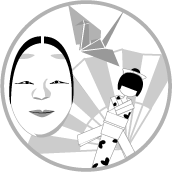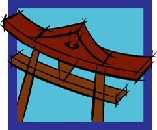| |
 Language Language
While some
believe that the Japanese language falls into its own unique category,
others insist that it is related to Korean, and maybe also to Polynesian
languages, or even to Turkish. Regardless, it is unlikely that you will
be able to relate the grammar or cognates (aside from loan words from
European languages) to any other language you may have studied.
Japanese word
order is generally characterized as being the reverse of that in English.
This is not so difficult once you have adjusted to it. What may be somewhat
harder to grasp is that sometimes concepts don’t fit together the
way an English speaker would expect. For example, if the instruction “Turn
left at this corner” is expressed in Japanese, “this corner”
is treated as a direct object: “Turn this corner left.”
Writing Systems
Japanese did
not have a writing system until Chinese characters were borrowed in the
5th century AD. However, since Japanese inflects much more than Chinese,
it was a poor fit, and those who were literate were essentially reading
and writing Chinese. In time, two sets of phonetic syllabaries, or kana,
evolved. Hiragana is generally used in combination with Chinese characters,
or kanji, for inflections of words, grammatical particles, and common
words for which the kanji are seldom used. Katakana is most commonly used
for words of foreign origin, though it is also used for things like names
of plant and animal species, and comic book sound effects. The two kana
systems have few irregularities (far fewer than the supposedly phonetic
English writing system) and can be learned fairly easily.
The reading
of kanji, however, is one of the most notorious sticking points of learning
Japanese. Not only is it not phonetic, but each character has two or more
pronunciations, and it can be difficult to remember—or guess—which
pronunciation is used in a given situation. However, it can help to remember
that the pronunciations fall into two basic categories: those that are
similar to the ancient Chinese pronunciation of the character (on-yomi)
and those that are native to Japanese (kun-yomi). As a general (but not
iron-clad) rule, the on-yomi are used in compounds of two or more kanji,
while kun-yomi are used when a single kanji stands by itself. Often, characters
to be pronounced using kun-yomi will be followed by hiragana showing the
inflection of the word, particularly if it is an adjective or adverb.
Once you start learning kanji, they will probably not seem as difficult
as you might have expected, though the sheer number of characters to learn
can be a bit daunting.
Polite Forms
Another notorious
difficulty of learning Japanese is that it is very situational. Various
levels of politeness are used, based on how well the speaker knows the
listener and where the two stand in terms of age and/or societal rank.
The different levels manifest themselves most often in different verb
endings (or entirely different verbs) and in the pronoun and honorific
suffix used in addressing the listener. If you study Japanese, you will
begin with the standard polite form which is sure to get you through any
normal situation without offending people. If you have Japanese friends,
you will likely learn the less polite forms used in more relaxed situations.
A word about
verbs: in the basic polite Japanese taught in beginning courses, the verbs
all end in -masu. However, this is the polite form of the verb, not the
“plain” form found in the dictionary. This makes it difficult,
if not impossible, to look up an unknown verb. If you study Japanese,
you’ll be doing yourself a favor by learning right away how to figure
out what the plain form of a verb is by looking at its -masu form.
View from
Japan home
|


 This page last updated
June 18, 2005
. E-mail Tim
This page last updated
June 18, 2005
. E-mail Tim